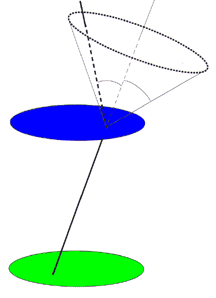Compton telescopes are typically used for very high-energy X-rays and gamma rays. Our current technology does not yet let us focus gamma rays with telescopes by re-directing photons to a detector like we do with optical and X-ray light. Instead, engineers have come up with other ways to pinpoint where in the sky gamma rays come from – a Compton telescope is one such detector.
Before talking about the Compton telescope itself, it's helpful to understand “Compton scattering,” which is one way that photons interact with matter. Compton scattering occurs when a photon “hits” an electron. The photon transfers some of its energy to the electron in the interaction. The interaction causes the photon to lose some energy and change its direction, as shown in the illustration below.
Compton telescopes use the Compton scatter interaction to detect the energy and location of gamma rays that enter the telescope. Compton telescopes are usually constructed in two layers. A cosmic gamma ray enters and scatters on an atom in the first layer. The resulting electron is detected through scintillation in the top layer and is observed by phototubes. The photon that results from the interaction passes through to the second layer of the telescope where it is absorbed and detected by another set of phototubes.

One challenge of Compton telescopes is that the line connecting the two interaction points in the detector do not coincide with the direction of the incoming cosmic gamma ray. Instead, the angle of the incoming gamma ray can be found using the data from both sets of phototube detectors. This angle defines a ring in the sky where the gamma ray could have come from.